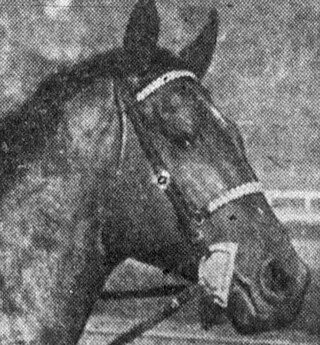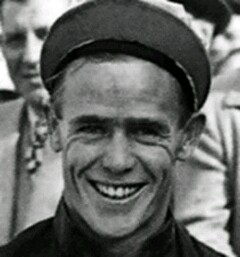Related Research Articles

Citation was a champion American Thoroughbred racehorse who is the eighth winner of the American Triple Crown. He won 16 consecutive stakes races and was the first horse in history to win US$1 million.
Equipoise (1928–1938) was an American Thoroughbred racehorse and sire. In a career which lasted from 1930 until 1935, he ran fifty-one times and won twenty-nine races. A leading two-year-old in 1930, he missed most of the next season, including two of the three American Triple Crown races through injury and illness. "Ekky" returned to the track in 1934 and proved to be a dominant champion, winning numerous important stakes races in the next three years. Equipoise died in 1938 after a short but promising stud career.

Earl Harold Sande was an American Hall of Fame jockey and thoroughbred horse trainer.

Zev (1920–1943) was an American thoroughbred horse racing Champion and National Museum of Racing and Hall of Fame inductee.

Samuel Clay Hildreth was an American Thoroughbred horse racing Hall of Fame trainer and owner.

Challedon (1936–1958) was an American Hall of Fame Champion Thoroughbred racehorse. Bred in Maryland by William L. Brann and Robert S. Castle, he raced under the colors of their Branncastle Farm.

Albert Snider was a jockey in Thoroughbred racing who had success in his native Canada as well as the United States.
The Havre de Grace Handicap was an American Thoroughbred horse race first run on the August 26, 1912 opening day of the new Havre de Grace Racetrack in Havre de Grace, Maryland. Although most of its runnings would take place in early fall, its final edition was run there on April 30, 1949. Due to Federal government wartime regulations, the 1943 edition was held at Laurel Park and in 1945 at Pimlico Race Course. A race for horses age three old or older, it was run on dirt over a distance of 1 1/8 miles with the exception of 1918 when it was set at 1 mile and 70 yards. From inception through 1939, the race was known as the Havre de Grace Cup Handicap.

Omar Khayyam (1914–1938) was a British-born Thoroughbred racehorse who was sold as a yearling to an American racing partnership and who became the first foreign-bred horse to win the Kentucky Derby. He was named for the famous Persian mathematician, poet, and astronomer, Omar Khayyam.
Purchase, an American Thoroughbred racehorse, was called "The Adonis of the Turf." Walter Vosburgh, the official handicapper for The Jockey Club as well as a turf historian for many years, wrote: "…one of the most exquisitely beautiful of racehorses…to describe Purchase would be to exhaust the superlative."

Milkmaid was an American two-time Champion Thoroughbred racehorse. She was bred by J. Hal Woodford at his farm in Bourbon County, Kentucky. Woodford had bred and raced the 1907 Kentucky Derby winner, Pink Star. Out of the mare, Nell Olin, her sire was the British import, Peep o' Day, a son of the great Ayrshire who won the 1888 2,000 Guineas Stakes and Epsom Derby then just missed winning the British Triple Crown when he ran second in the St. Leger Stakes.
Pavot was an American Thoroughbred Champion racehorse. In a career that lasted from 1944 to 1946 he ran thirty-two times and won fourteen races. He was the leader of his generation in 1944 when he was named American Champion Two-Year-Old Colt. The following year he recorded his most important win in the Belmont Stakes.
Thomas J. Healey was an American Thoroughbred horse racing Hall of Fame trainer.
Dr. Freeland was an American Thoroughbred racehorse best known for his win in the Preakness Stakes, the then first leg of the 1929 United States Triple Crown of Thoroughbred Racing. He was named for Dr. John Freeland, a prominent New York City banker.
Bostonian was an American Thoroughbred racehorse. The son of Broomstick out of a Peter Pan mare Yankee Maid, Bostonian is best remembered for posting a 1-1/2 length win over his stablemate and Kentucky Derby Champion Whiskery in the mile and three sixteenth $65,000 Preakness Stakes at Pimlico Race Course on May 9, 1927
Buskin was an American Thoroughbred racehorse is best known for winning the 1913 Preakness Stakes. Owned and trained by John Whalen, he was sired by Hamburg. Buskin was out of the mare Slippers, a daughter of Meddler.
The 1928 Preakness Stakes was the 53rd running of the Preakness. The race took place on Friday, May 11, 1928, eight days before the Kentucky Derby making it the first leg of the U.S. Triple Crown series. A horse race for three-year-old thoroughbreds, it carried a total purse of $71,370. It was run on a track rated fast in a final time of 2:00 1/5. Ridden by future U.S. Racing Hall of Fame inductee Raymond Workman, Victorian won the race by a nose over runner-up Toro. Nassak, the betting favorite from the powerful Rancocas Stable finished a distant 11th. The fifth-place finisher, Sun Beau, went on to a brilliant racing career and was voted U.S. Champion Older Horse in three straight years culminating with his 1996 induction into the U.S. National Museum of Racing and Hall of Fame.
The Empire City Derby was an American Thoroughbred horse race held annually from 1917 through 1933 at Empire City Race Track in Yonkers, New York. A race for three-year-old horses of either sex, the event was contested at a mile and one-eighth at inception until 1920 when it was set at what became known as the "Derby distance" of a mile and one-quarter. With the Brooklyn Derby at Belmont Park having changed its name to the Dwyer Stakes, the Empire City Derby was then the only Derby event in the Northeastern United States.
The Chesapeake Stakes was an important American Thoroughbred horse race for three-year-old horses of either sex contested on dirt over a distance of a mile and one-sixteenth at Havre de Grace Racetrack in Havre de Grace, Maryland. Run from 1920 until the track closed after the 1950 edition, the race usually run in late April race was a last major prep before the Kentucky Derby. For owners who had not nominated their horse for the Derby it was a chance to test their horse's ability against some of the best three-year-olds in the country, a number of which they would undoubtedly encounter in the ensuing Preakness Stakes.
The Bowie Handicap at Pimlico Race Course in Baltimore, Maryland was a Thoroughbred horse race run between 1909 and 1938. A race on dirt, this once much anticipated event that drew some of the very best horses in the country was contested at distances from a mile and one-quarter to as much as two miles.
References
- 1 2 "PREAKNESS TO SALMON'S VIGIL". Los Angeles Times. 1923-05-13. Archived from the original on January 31, 2013. Retrieved 2012-08-06.
- ↑ Bowen, Edward L. Legacies of the Turf: A Century of Great Thoroughbred Breeders , p. 71 (2003) Eclipse Press ISBN 978-1-58150-102-5
- ↑ "Vigil pedigree". equineline.com. 2012-05-08. Retrieved 2012-08-06.
- ↑ "Care - Family 27-a". Bloodlines.net. Retrieved 2012-08-06.
- ↑ "$5,000 DEMOISELLE STAKES TO CRESTA" (PDF). New York Times. 1922-07-11. Retrieved 2012-08-06.
- ↑ "Daily Racing Form 1920s". Kdl.kyvl.org. Retrieved 2012-08-06.